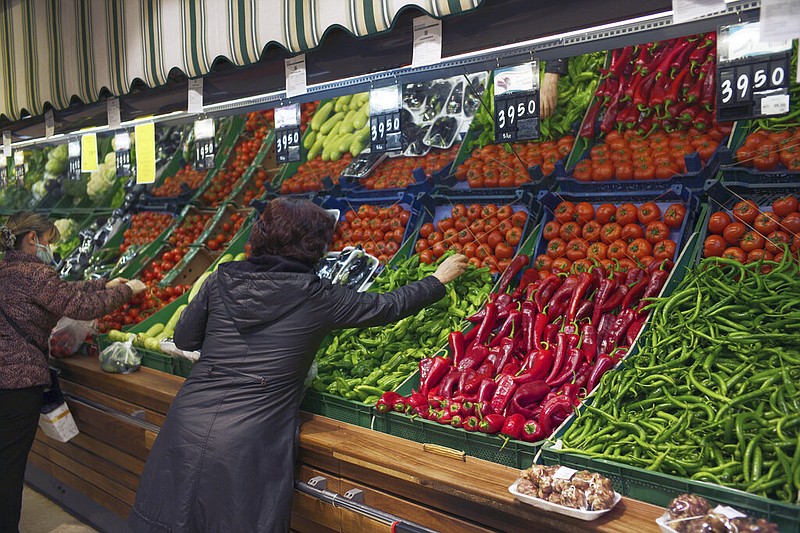ROME -- Prices for food commodities such as grains and vegetable oils reached their highest levels on record last month, threatening millions of people in Africa, the Middle East and elsewhere with hunger and malnourishment, the United Nations said Friday.
The U.N. Food and Agriculture Organization said its Food Price Index, which tracks monthly changes in international prices for a basket of commodities, averaged 159.3 points last month, up 12.6% from February. The index in February hit its highest level since its inception in 1990.
The Food and Agriculture Organization said Russia's war in Ukraine was largely responsible for the 17.1% rise in the price of grains, including wheat and others such as oats, barley and corn. Together, Russia and Ukraine account for about 30% and 20% of global wheat and corn exports, respectively.
While predictable given February's steep rise, the figure for March "is really remarkable," said Josef Schmidhuber, deputy director of the Food and Agriculture Organization's markets and trade division. "Clearly, these very high prices for food require urgent action."
The biggest price increases were for vegetable oils: that price index rose 23.2%, driven by higher figures for sunflower seed oil that is used for cooking. Ukraine is the world's leading exporter of sunflower oil, and Russia is No. 2.
"There is, of course, a massive supply disruption, and that massive supply disruption from the Black Sea region has fueled prices for vegetable oil," Schmidhuber told reporters in Geneva.
He said he couldn't calculate how much the war was to blame for the record food prices, noting that poor weather conditions in the United States and China had created crop concerns. But he said that "logistical factors" were playing a big role.
"Essentially, there are no exports through the Black Sea, and exports through the Baltics is practically also coming to an end," Schmidhuber said.
The surging costs are spurring some countries to hold off on imports, seek new suppliers or draw down local stockpiles, though those won't be long-term fixes, said Erin Collier, an economist at the Food and Agriculture Organization.
"It's basically kind of deterring demand," she said. "That can only last for so long. Wheat is a staple food."
The soaring food prices and disruption to supplies coming from Russia and Ukraine have threatened to worsen food shortages in countries in the Middle East, Africa and parts of Asia where many people already were not getting enough to eat.
Those nations rely on affordable supplies of wheat and other grains from the Black Sea region to feed millions of people who subsist on subsidized bread and bargain noodles, and they now face the possibility of further political instability.
The U.N. has warned that prices could still climb much more.
That's bad news for the world's hunger problem. Cost increases stemming from the war and resulting sanctions on Russia will -- without action -- push more than 40 million additional people into extreme poverty, according to an analysis published last month by the Center for Global Development, a nonprofit think tank whose funders include Bloomberg Philanthropies.
Grain producers like the United States, Canada, France, Australia and Argentina are being closely watched to see if they can quickly ramp up production to fill in the gaps, but farmers face issues such as climbing fuel and fertilizer costs exacerbated by the war, as well as drought and supply chain disruptions.
In the Sahel region of Central and West Africa, the disruptions from the war in Ukraine have added to an already precarious food situation caused by covid-19, conflicts, poor weather and other structural problems, said Sib Ollo, senior researcher for the World Food Program for West and Central Africa in Dakar, Senegal.
"There is a sharp deterioration of the food and nutrition security in the region," he told reporters, saying 6 million children are malnourished and nearly 16 million people in urban areas are at risk of food insecurity.
Farmers, he said, were particularly worried that they would not be able to access fertilizers produced in the Black Sea region. Russia is a leading global exporter.
"The cost of fertilizers has increased by almost 30% in many places of this region because of the supply disruption that we see provoked by a crisis in Ukraine," Ollo said.
The World Food Program has appealed for $777 million to meet the needs of 22 million people in the Sahel region and Nigeria over six months, he said.
To address the needs of food-importing countries, the Food and Agriculture Organization is developing a proposal for a mechanism to alleviate the import costs for the poorest countries, Schmidhuber said. The proposal calls for eligible countries to commit to added investments in their own agricultural productivity to obtain import credits to help soften the blow.
The problems will also drag into the next season. Ukraine planted its wheat months before the war began, and the Food and Agriculture Organization expects at least 20% to go uncollected because of destruction, constrained access to fields or a lack of resources for harvests. Russian production could also be affected by the war, it said.
"Looking forward to 2022-23, we're already seeing signs that production is going to be reduced in Ukraine," Collier said. "The amount they're able to export really depends on how much longer this conflict continues."
Information for this article was contributed by Nicle Winfield of The Associated Press and Megan Durisin of Bloomberg News (WPNS).
